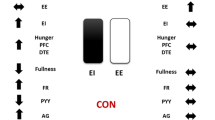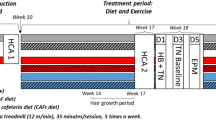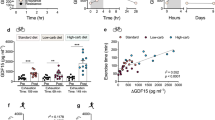Abstract
Energy balance is the resultant of ingested calories and energy expenditure and is generally maintained within narrow limits over prolonged periods. Exercise leads to an increase in energy expenditure which is, in the long-term, counteracted by increased energy intake. Evidence for this comes from a study in voluntarily running female rats that increased their daily food intake to 130% of the sedentary controls. In contrast, when considered on a short-term basis, exercise will suppress food intake to prevent a potentially dangerous disruption of energy substrate homeostasis. Studies in permanently cannulated rats submitted to a test meal and 2 hrs swimming reveal that both food intake and exercise lead to increases in glucose and free fatty acid (FFA) levels in the blood. These changes in glucose and FFA, combined with the exercise-induced alteration in among others glucagon, corticotropin releasing hormone (CRH) and body temperature, may lead to the short-term anorexic effect of exercise.
This is a preview of subscription content, access via your institution
Access options
Subscribe to this journal
Receive 12 print issues and online access
$259.00 per year
only $21.58 per issue
Buy this article
- Purchase on Springer Link
- Instant access to full article PDF
Prices may be subject to local taxes which are calculated during checkout
Similar content being viewed by others
Author information
Authors and Affiliations
Rights and permissions
About this article
Cite this article
Scheurink, A., Ammar, A., Benthem, B. et al. Exercise and the regulation of energy intake. Int J Obes 23 (Suppl 3), S1–S6 (1999). https://doi.org/10.1038/sj.ijo.0800876
Published:
Issue Date:
DOI: https://doi.org/10.1038/sj.ijo.0800876
Keywords
This article is cited by
-
High-intensity intermittent exercise attenuates ad-libitum energy intake
International Journal of Obesity (2014)
-
The Effect of Repeated Episodes of Dietary Restriction and Refeeding on Systolic Blood Pressure and Food Intake in Exercise‐Trained Normotensive Rats
Obesity Research (2000)



